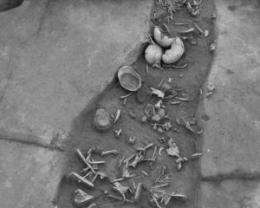December 7, 2009 weblog
Evidence unearthed of possible mass cannibalism in Neolithic Europe

(PhysOrg.com) -- Archaeologists studying a 7,000-year-old site in what is now south-west Germany have found evidence suggesting that more than 500 people may have been the victims of cannibalism.
Evidence of cannibalism in Neolithic Europe is rare, but hundreds of remains excavated at a site near the village of Herxheim have markings suggestive of cannibalism. One of the authors of the research paper, Dr Bruno Boulestin of the University of Bordeaux in France, said his team had found bones with markings similar to those found on the remains of animals that have been spit roasted. They also found cuts suggestive of meat being scraped from the bones, and bones with the ends broken, as if to facilitate scraping out the marrow.
Dr Boulestin said the cuts and markings on the bones provided evidence the bodies of the more than 500 victims, including children and fetuses, were intentionally mutilated, and the victims were butchered and eaten in the same way as animals.
The archaeological site is one of the Linear Pottery Culture, and was first excavated from 1996-99 and again in 2005 and 2008. So far the remains of about 500 humans and a large number of dogs have been found buried in oval pits. The pits also contained pottery, which suggests the remains were accumulated over only a few decades. The remains date from the early Neolithic period, when farming had spread into Europe.
Two German scientists, Miriam Haidle of Senckenberg Research Institute and Natural History Museum in Frankfurt, and J?rg Orschiedt of the University of Leipzig, who have previously studied bones found at the site dismiss Dr Boulestin's theory of cannibalism and suggest the removal of flesh was more likely to have been part of a reburial ritual.
Boulestin's team originally also thought the find was a reburial site, but they became convinced the people had been cannibalized after a detailed examination of 217 samples of bone from at least 10 people, including two unborn children, revealed chewing and scraping marks that were more consistent with cannibalism.
According to Haidle and Orschiedt bones of people who had been ritually reburied would have had similar markings, and cannibalism would be almost impossible to prove.
Herxheim and other settlements were abandoned around the time of the deaths of the people, about 7,000 years ago, which may indicate there was a social crisis of some kind at the time. Excavations are continuing, and Dr Boulestin and his team think the site may contain the remains of many more people.
The paper is published in the December edition of the journal Antiquity.
More information: Mass cannibalism in the Linear Pottery Culture at Herxheim (Palatinate, Germany), Volume: 83 Number: 322 Page: 968-982, antiquity.ac.uk/ant/083/ant0830968.htm
© 2009 PhysOrg.com
















